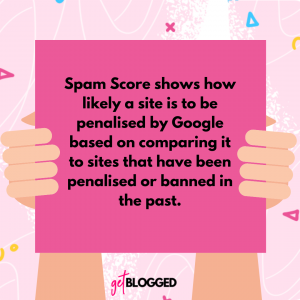Developed by SEO software company Moz.com Spam Score serves as a metric to determine the quality of a domain based on comparison to domains that have been found to be penalised or banned by Google. This score enables search marketers to more accurately judge the quality and relevance of a site and the risk level involved with procuring links on third party sites. Spam Score is found as part of the Moz Link Explorer Tool.
Spam Score is based on a machine learning model which identifies 27 common features among the millions of banned or penalised sites in the data fed into it, determining correlation with penalisation rather than causation.

A score of 1%-30% is considered a low Spam Score, 31%-60% medium and 61%-100% is considered a high Spam Score.
It’s worth considering that Moz says that a high Spam Score doesn’t always mean that the site in question is spammy, as Spam Score represents a wide variety of potential signals ranging from content concerns to low authority metrics, but it is a sign that a more thorough examination of the site should take place.
If your site hasn’t had a Google penalty then you shouldn’t be worried about a low or medium spam score for your site; in this case, Spam Score is best used to judge the quality of links pointing to the site. A link with a higher Spam Score linking to yours may need further investigation or to be removed.
The same goes for checking a third party site’s Spam Score as a way of choosing whether or not to place a link on it. A higher Spam Score doesn’t mean you should count these sites out altogether, but an indicator to check out the site’s content and its relevance in linking back to your site before it is disregarded.


 rated
rated




![6 ways to collaborate with bloggers this Thanksgiving [with case studies]](https://getblogged.net/wp-content/uploads/2022/10/pexels-rodion-kutsaiev-10060431-300x300.jpg)


![Blogger's guide to seasonal gift guides [+ 20 ideas to steal]](https://getblogged.net/wp-content/uploads/2022/09/pexels-ray-piedra-1502219-300x200.jpg)
![17 Blogger Marketing Ideas For September & October 2022 [+ Traffic Trends]](https://getblogged.net/wp-content/uploads/2022/09/pexels-lukas-628244-300x199.jpg)









